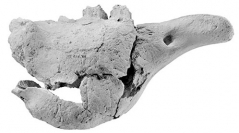

 Geodiversitas
23 (4) - Pages 625-645
Geodiversitas
23 (4) - Pages 625-645A new species of Megatherium Cuvier, 1796, M. altiplanicum n. sp., from the Montehermosan (Pliocene) of the north central Altiplano of Bolivia is described. It represents the earliest and smallest species of its genus and is the sister species of Megatherium americanum Cuvier, 1796 based on the following synapomorphies: very deep horizontal ramus of the dentary, prominent torsion of the femoral diaphysis, relatively concave medial and lateral femoral margins, and reduced patellar trochlea. The premaxillae are derived in being fused to each other and the maxilla, and relatively robust, features shared with M. americanum and M. tarijense Gervais & Ameghino, 1880, but those of M. americanum are more robust and quadrangular. In size, the new species resembles Eremotherium sefvei De Iuliis & Saint-André, 1997, but in the latter the femoral diaphysis is moderately twisted, the femoral margins are more nearly rectilinear, and the patellar trochlea unreduced. The presence of the new species in the Montehermosan suggests that the genus Megatherium had emerged by the beginning of the Pliocene, and that the most recent common ancestor of the clade (including also M. americanum and M. tarijense), predates the Pliocene. Megatherium was apparently adapted to a temperate climate, as opposed to the more tropical range occupied by Eremotherium Spillmann, 1948. The discovery of the new species possibly indicates broad ecological similarity between the Pliocene Altiplano and the Argentinian lowlands, and that the clade may have originated on the Altiplano.
Xenarthra, Megatheriidae, Megatherium, Pliocene, Bolivia, Montehermosan, new species